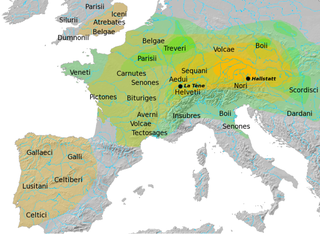
The La Tène culture was a European Iron Age culture. It developed and flourished during the late Iron Age, succeeding the early Iron Age Hallstatt culture without any definite cultural break, under considerable Mediterranean influence from the Greeks in pre-Roman Gaul, the Etruscans, and the Golasecca culture, but whose artistic style nevertheless did not depend on those Mediterranean influences.

Ljubljana is the capital and largest city of Slovenia, located along a trade route between the northern Adriatic Sea and the Danube region, north of the country's largest marsh, inhabited since prehistoric times. It is the country's cultural, educational, economic, political and administrative center and the seat of Urban Municipality of Ljubljana.

Kobarid is a settlement in Slovenia, the administrative centre of the Municipality of Kobarid.

The Hallstatt culture was the predominant Western and Central European archaeological culture of the Late Bronze Age from the 12th to 8th centuries BC and Early Iron Age Europe from the 8th to 6th centuries BC, developing out of the Urnfield culture of the 12th century BC and followed in much of its area by the La Tène culture. It is commonly associated with Proto-Celtic speaking populations.

Emona or Aemona was a Roman castrum, located in the area where the navigable Nauportus River came closest to Castle Hill, serving the trade between the city's settlers – colonists from the northern part of Roman Italy – and the rest of the empire. Emona was the region's easternmost city, although it was assumed formerly that it was part of the Pannonia or Illyricum, but archaeological findings from 2008 proved otherwise. From the late 4th to the late 6th century, Emona was the seat of a bishopric that had intensive contacts with the ecclesiastical circle of Milan, reflected in the architecture of the early Christian complex along Erjavec Street in present-day Ljubljana.

Velenje is the sixth-largest city of Slovenia, and the seat of the Municipality of Velenje. The city is located in the traditional Slovenian region of Styria, among the rolling green hills of the Šalek Valley, with the Kamnik–Savinja Alps to the west and the Pohorje Mountains to the east.
The Arras culture is an archaeological culture of the Middle Iron Age in East Yorkshire, England. It takes its name from the cemetery site of Arras, at Arras Farm, (53.86°N 0.59°W) near Market Weighton, which was discovered in the 19th century. The site spans three fields, bisected by the main east-west road between Market Weighton and Beverley, and is arable farmland; little to no remains are visible above ground. The extent of the Arras culture is loosely associated with the Parisi tribe of pre-Roman Britain.

Kydonia, also known as Cydonia was an ancient city located at the site of present-day Chania on the island of Crete in Greece. The city is known from archaeological remains dating back to the Minoan era as well as literary and historical sources.

Lovas is a village and seat of municipality in the Vukovar-Syrmia County of eastern Croatia, located on the slopes of Fruška Gora, a few kilometers south of the main road connecting Vukovar with Ilok. Lovas has a population of 1,214 (2011), and its municipality also includes the smaller village of Opatovac which is located to the north, at the Danube. Lovas is underdeveloped municipality which is statistically classified as the First Category Area of Special State Concern by the Government of Croatia.

The Burgstallkogel is a hill situated near the confluence of the Sulm and the Saggau river valleys in Southern Styria in Austria, about 30 km south of Graz between Gleinstätten and Kleinklein. The hill hosted a significant settlement of trans-regional importance from 800 BC to about 600 BC. Surrounding the hill is one of the largest Iron Age necropolises in continental Europe, originally composed of at least 2,000 tumuli.
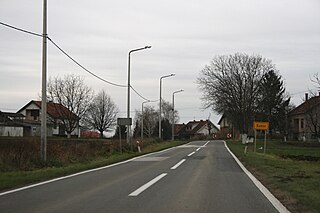
Sotin is a village in eastern Croatia, located a few kilometers southeast of Vukovar by the Danube. It is administratively part of the city of Vukovar, and its population is 597. The post code for Sotin is 32232 Sotin.

The architecture of Slovenia has a long, rich and diverse history.

Bele Vode is a settlement in the Municipality of Šoštanj in northern Slovenia. It lies in the Mozirje Hills northwest of the town of Šoštanj. The area is part of the traditional region of Styria. The entire municipality is now included in the Savinja Statistical Region. The settlement includes the hamlets of Kloše, Punčkov Vrh, Visočki Vrh, and Zaloka.

The appearance of Celts in Transylvania can be traced to the later La Tène period . Excavation of the great La Tène necropolis at Apahida, Cluj County, by S. Kovacs at the turn of the 20th century revealed the first evidence of Celtic culture in Romania. The 3rd–2nd century BC site is remarkable for its cremation burials and chiefly wheel-made funeral vessels.

Zagorica pri Velikem Gabru is a village in the Municipality of Trebnje in eastern Slovenia. It lies just south of the A2 motorway in the historical region of Lower Carniola. The municipality is now included in the Southeast Slovenia Statistical Region.
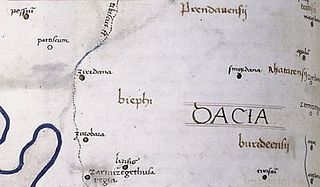
Ziridava was a Dacian town located between Apulon and Tibiscum, mentioned by Ptolemy in the area of the Dacian tribe of Biephi.
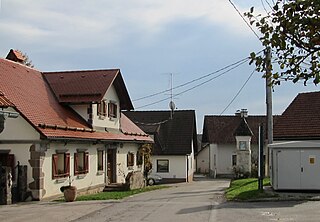
Zgornja Slivnica is a settlement in the Municipality of Grosuplje in central Slovenia. It lies in the hills north of Grosuplje and northeast of Šmarje-Sap and south of Mali Lipoglav in the historical region of Lower Carniola. The municipality is now part of the Central Slovenia Statistical Region.

Rifnik Hill is a hill with an archaeological open-air museum in eastern Slovenia. The archaeological park consists of a reconstruction of a Hallstatt house from the late Bronze Age. Early Iron Age burial mounds were also found on its northern and eastern slopes. A temple dedicated to Aqvon, the deity of the Voglajna River, was built in the Late Roman era, on the foundations of which an early Christian church was later built, and on the western edge of the hill there was another church, where Arianism was practiced.

Ljudmila Plesničar Gec was a Slovenian archaeologist who specialized in uncovering the Roman history of Ljubljana. Best known for her excavations at Emona, she received the Valvasor Prize in 1985, the Golden Order of Freedom of the Republic of Slovenia in 1997, and was honored in 2000 with the Lifetime Achievement Award from the Archaeological Society of Slovenia.
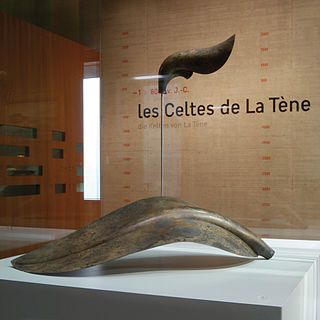
La Tène is a protohistoric archaeological site on the northern shore of Lake Neuchâtel, Switzerland. Dating to the second part of the European Iron Age it is the type site of the La Tène culture, which dates to about 450 BCE to the 1st century BCE and extends from Ireland to Anatolia and from Portugal to Czechia. La Tène is listed as a property of national significance.


















